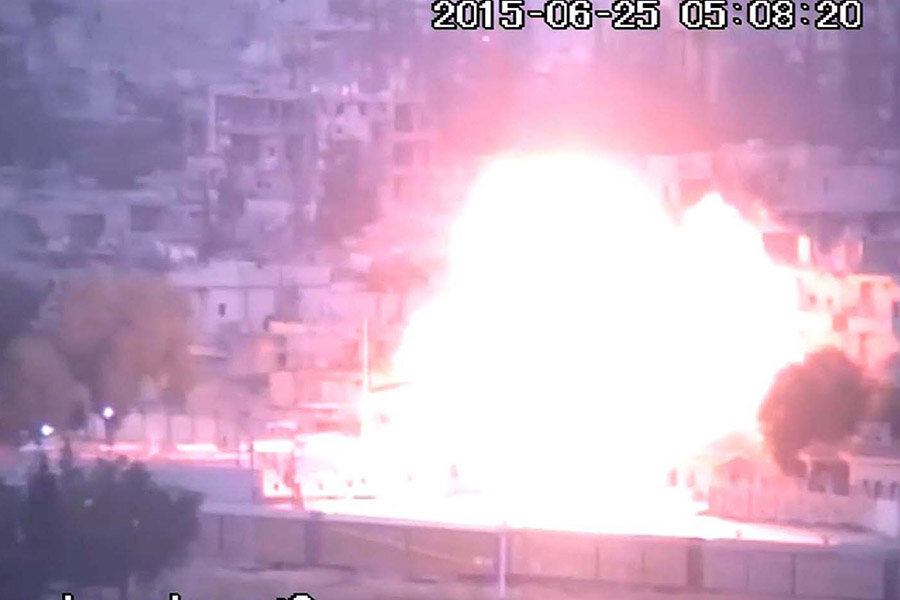ISIS trying to retake Kobane in northern Syria
Loading...
| Beirut
Islamic State militants launched two major attacks in northern Syria on Thursday, storming government-held areas in the mostly Kurdish city of Hassakeh and pushing into Kobane — the Syrian Kurdish border town they were expelled from early this year — where they set off three cars bombs, killing and wounding dozens, activists and officials said.
The attacks came after the Islamic State group suffered several setbacks in northern Syria against Kurdish forces over the past weeks.
In Kobane, which famously resisted a months-long assault by the Islamic militants before driving them out in January, an activist group said 10 people died in fighting Thursday — the first time in six months the IS had managed to enter the town along the Syria-Turkey border.
In the city of Hassakeh, Redur Khalil, a spokesman for the Kurdish People's Protection Units, or YPG, said IS militants attacked government-held neighborhoods on the southern edge of the city, and captured some areas. Hassakeh is divided between Syrian President Bashar Assad's forces and Kurdish fighters.
Syrian state TV reported intense clashes inside Hassakeh's southern neighborhood of Nashawi. According to the report, IS fighters killed several people they captured in the city, including the head of a military housing institution. It said the militants sustained many casualties, including the commander of the group who is a foreign fighter.
IS tried to storm the city earlier this month and reached its southern outskirts before facing strong resistance from Syrian government troops who pushed them away.
The attacks on Hassakeh and Kobane came just days after YPG fighters and their allies captured the Islamic State stronghold of Tal Abyad on the border with Turkey and the town of Ein Issa to the south. Kurdish fighters have been advancing since January under the cover of airstrikes by the U.S.-led coalition.
But in neighboring Iraq, government forces and allied Shiite militiamen have been slow in retaking IS-held territory. The Iraqis have also suffered occasional losses.
Iraqi troops drove IS militants from Saddam Hussein's hometown of Tikrit in April, but lost Ramadi, the capital of Anbar province west of Baghdad, last month.
In June last year, the Islamic State group launched a blitz, capturing large parts of both Syria and Iraq and subsequently declared an Islamic caliphate on the territory it controls. A major IS attack was widely expected during the Muslim holy month of Ramadan, which began last week.
In an audio message Tuesday, IS spokesman, Abu Muhammad al-Adnani, urged Sunni Muslims to use the time of piety and dawn-to-dusk fasting during Ramadan to wage jihad and seek martyrdom.
"Attack them everywhere and shake the ground beneath them," he said. It was not possible to verify the recording, but it resembled previous audio statements from the group.
Al-Adnani referred to the recent battlefield setbacks for IS, saying the faithful "may lose a battle or battles and may lose towns and areas, but will never be defeated."
Thursday's attack in Kobane involved at least one suicide car bombing, according to Kurdish officials. The Britain-based Syrian Observatory for Human Rights, which tracks Syria's war, said three vehicles were detonated in the town.
Ghalia Nehme, a commander with the Kurdish Women's Protection Units, told The Associated Press by telephone from inside the border town that "a group of fighters deployed in some areas of Kobane."
"We are defending a position now," she added.
Another Kurdish official in Kobane, Idriss Naasan, said the fighting was intense in the morning but became more sporadic by midday. He said the extremists appear to have infiltrated from villages south of Kobane.
"We hear cracks of gunfire every now and then," Naasan said from inside Kobane around noon on Thursday. He added that some explosions could still be heard but that it was unclear what those were.
The Observatory said Thursday's fighting in Kobane had killed 10 civilians and Kurdish fighters, and also three IS extremists.
After months of bloody street fighting, the Kurdish forces in Kobane, which lies along the Syria-Turkey border, succeeded in pushing out IS militants earlier this year. That was a landmark victory against the IS, enabled in part by the U.S.-led coalition's airstrikes.
Two Turkish officials said Thursday's attack in Kobane involved a suicide bomber who detonated his car near the border gate that separates Kobani from the Turkish town of Mursitpinar.
Surveillance footage seen by The Associated Press showed a fiery explosion rocking Kobane in the dim light of dawn.
The official said the video came from one of the 24 cameras monitoring the border crossing.
Both officials spoke on condition of anonymity because they were not authorized to talk to reporters.
Turkey's Deputy Prime Minister Numan Kurtulmus said in a statement posted to Twitter that 96 people had been wounded in the fighting in Kobane and that four people were killed Thursday. Such conflicting casualty figures have been common in the fighting in Syria and the immediate aftermath of big attacks.
Syrian state TV said the extremists crossed from the Turkish side of the border into Kobane, adding that are casualties. It gave no further details.





